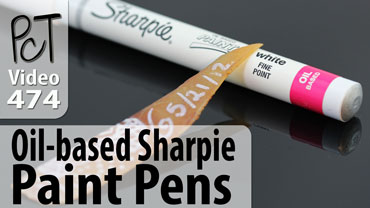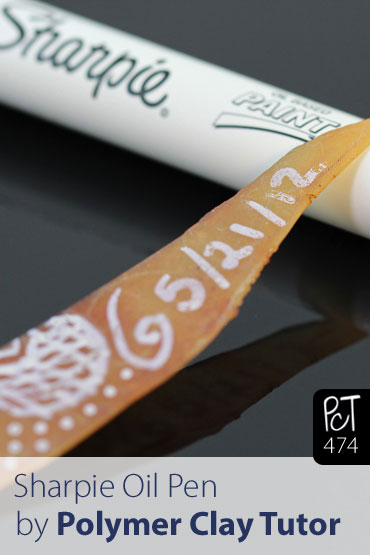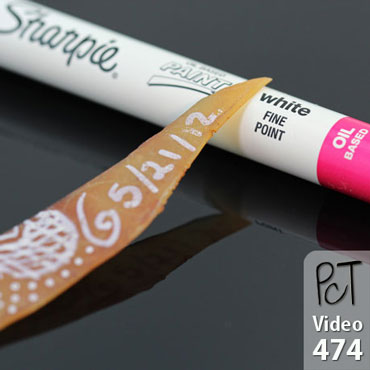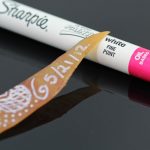Using Sharpie Oil Based Paint Pens on Polymer Clay
Video #474: After a year and a half, this product does pass compatibility testing.
More...
IN THIS POST: — sharpie — oil based — paint pen — writing on polymer clay — pens — markers — polymer clay compatible – polymer clay safe pens — (Topics marked with an asterisk* are discussed in the Comments Section below).
Topics Covered In This Video:
- Testing Sharpie Oil Based Paint Pen on Baked Polymer Clay (Premo Brand).
- Test sample start date was May 21, 2012 (1.5 years ago).
- No compatibility issues.
- No stickiness over time.
- Paint is durable and can not be scratched off with fingernail.
- Paint did not chip or flake when the sample was bent.
- Surprised that the oil based pen was compatible with the baked polymer clay, since it is generally thought that oil based paints will react with cured polymer clay. Need to do more testing with oil based products and polymer clay to test that theory.
- Pens need to be shaken to get free flowing.
- Paint can be heat set with an embossing gun or air dried.
- Not mentioned in the video, but the Sharpie Oil Based Paint Pen can be easily removed when wet or dry, with Isopropyl Alcohol (Rubbing Alcohol).
00:00:03 –> 00:00:08 Hi guys, its Cindy Lietz, your Polymer Clay Tutor, and in today’s PcT Test Lab, we are
00:00:08 –> 00:00:15 testing the Sharpie Oil-Based Paint pen on Polymer clay.
00:00:15 –> 00:00:24 Now, about…let’s see, about back in May of 2012, I took a scrap piece of Polymer clay…this
00:00:24 –> 00:00:31 happens to be a piece of Translucent that I had done some other things to, but I drew
00:00:31 –> 00:00:37 on it with this Sharpie Oil-Based pen to see how it would react with Polymer clay over
00:00:37 –> 00:00:46 time, and as you can see, it’s been on there for a year…almost 2 years now, and it is
00:00:46 –> 00:00:51 tough, there’s no stickiness, so it’s obviously compatible.
00:00:51 –> 00:00:56 I can scrape at it with my fingernail and it won’t come off, so it means it’s not
00:00:56 –> 00:01:01 gonna get rubbed off at another time, it doesn’t flake or chip even on this flexible piece,
00:01:01 –> 00:01:03 so it’s perfectly suited for Polymer clay.
00:01:03 –> 00:01:09 Now I was a little bit surprised by that because it is an oil-based pen, and from what I’ve
00:01:09 –> 00:01:18 been taught, oil doesn’t do well… usually, on baked Polymer clay pieces, and it usually
00:01:18 –> 00:01:22 will react over time, so I’m gonna be doing some more testing on some other oil-based
00:01:22 –> 00:01:26 products to see it that theory is actually correct.
00:01:26 –> 00:01:31 Now I’ll just quickly show you how these pens work, you need to shake them…they have
00:01:31 –> 00:01:37 a little ball inside, and they’re those kind of pens that you usually have to push
00:01:37 –> 00:01:43 down on the tip to get them to start running, so you can do that on a piece of paper or
00:01:43 –> 00:01:44 whatever.
00:01:44 –> 00:01:49 And I’ve just got a piece of baked Polymer clay here that I can…well hopefully my hands
00:01:49 –> 00:01:53 aren’t in the way, but I’m just going to draw on it, you can…you know, you can
00:01:53 –> 00:01:59 put whatever pattern you wanted, and this would be a neat thing to do for, you know
00:01:59 –> 00:02:04 doctoring up something that didn’t turn out so well, you could do all that Zentangle
00:02:04 –> 00:02:07 stuff on it and whatever you want.
00:02:07 –> 00:02:14 So, it works really well, you could heat set it with a heat gun, it only takes a few minutes…or
00:02:14 –> 00:02:21 I mean a minute or so, and…or you can just let it air dry, either way will be fine, and
00:02:21 –> 00:02:26 you’ve got a neat piece with some great embellishments on there.
00:02:26 –> 00:02:31 So I hope you enjoyed that, if you did, make sure to click that like button I really appreciate
00:02:31 –> 00:02:32 it.
00:02:32 –> 00:02:39 And my question for you today is, have you tried any paint pens on Polymer clay, and
00:02:39 –> 00:02:41 did they work or didn’t they?
00:02:41 –> 00:02:44 I’d love to hear from you, leave those comments in the comment section below.
00:02:44 –> 00:02:48 And don’t forget to subscribe to our channel, we have new videos that come out every week
00:02:48 –> 00:02:50 and you’re not gonna wanna miss a thing.
00:02:50 –> 00:02:52 We’ll see you next time and bye for now.
Our goal is to translate these videos into as many languages as possible. If you are interested in helping with this initiative, then please do contact us and we will figure out a way to make it worth your while :)
Resource Links:
- Amazon: Sharpie Oil Based Markers **
- Related Video: Testing Pebeo Fantasy Paints on Souffle Polymer Clay
- Related Video: My Distress Crackle Paint Test – Perplexing Results
- Related Video: Testing Tim Holtz Distress Ink & Stain on Polymer Clay
- Related Video: Using Pinata Alcohol Inks For Tinting Premo Clay
Resources marked with a double ** asterisk are affiliate links. If you click on them and decide to buy something, we may receive some compensation. This does not affect the price you pay in any way. What it does do, however, is helps us to continue providing free videos for you, here at the PcT website. Using our links to purchase your tools and supplies, is always greatly appreciated.
Sponsored Ads & Special Promotions

Shareable Images



To share this full blog post anywhere on the web that allows links in comments, here's a shortened url to copy and paste...
>> https://mypct.ca/v474 <<

Want to chat about today’s post? That’s what the comment section below is for. Scroll Down… We’d love to hear from you!
Or... if you would like to request a topic for a future post, here is the link to do that… PcT Suggestion Box

HI! Would anyone know if you can use Artline 900xf silver or gold metallic pens on polymer clay? I’ve tried googling this but can’t find an answer. I can’t see clearly on the product if it is oil or acrylic based. Otherwise, can anyone recommend a good silver metallic paint pen or paint?
Hi Emma, I’m sorry but I haven’t tested those pens yet so I don’t have any useful information for you. I also do not have a good suggestion for a replacement metallic pen either. Maybe someone else here knows what will work for you?
Hi Cindy,
For many years I have been using colored pencil on cured polymer clay and have yet to find a good, permanent sealer, even using PYMII the color eventually fades. Any suggestions?
Also I want to draw with graphite pencil directly onto cured, light colored clay but again do not know how it can be sealed without changing or distorting the drawing. I have searched the internet for tutorials or products that might work but have come up empty. Any ideas or places to go for more info?
You do a great job and offer a wonderful service to the PC community!
Thank you.
Grace, have you considered using a thin layer of resin as a coating over your coloured pencil? It should be compatible. The only downside I can think of right now would be that it would result in a super-shiny finish. That’s great if that’s what you want but could be less good if you wanted a more matte surface. One other upside with resin is durability.
I thought of that but I do not want a shiny surface. My work is pretty unglitsy.
Have you tried the Duraclear by DecoArt? It comes in Gloss, Matte, Satin. I use the liquid and handpaint paper beads. I have used this for over four years. Check out their website. Decoart. They also make all the Americana paints. This is my go-to sealant. It is non-yellowing, nontoxic, and waterproof. No fumes! Hope this helps. I order mine direct online but sometimes you can find it in Michael’s and Hobby Lobby.
Hi Grace, what pencils are you using? Perhaps the pigments in the pencils that you are using are not actually lightfast? Many paints, pencils and other art materials contain pigments that will fade over time. I was watching a YouTube video the other day (posted just below), that was talking about the lightfast ratings for the different pencils and even the different colors with in the lines. What I am saying it may not be the coating that is the issue here, but the actual pencils themselves.
That is a very good possibility that I have not considered. I am using mostly Prismacolor pencils and some colors do seem to fade easier than others so you might have something there. Going to look into that further. Thank you.
Cindy,think you are really onto something here…… thank you so much for pointing me in this direction.
You’re welcome. Sometimes the reason something is having an issue is because of a reason, that isn’t as obvious as we think. I am trying really hard to learn as much about as many materials as I can, so that I can be a better problem solver. (Besides I just love learning about art supplies and tools, so it is a real pleasure absorbing as much info as I can.)
Before watching that video I did know about the light fastness of paints but it didn’t occur to me that the same could be true for pencils. Now that I do know that… I bet the same is true for many other art materials as well. Now we have a new piece of knowledge that will help us in projects in the future, like in this case. Isn’t it so cool to learn something new?
Hi, I acquired a gold colored polymer clay jewellery several years ago and it turned dark. I got a gold colored oil based marker pen and colored it. The restoration was stunning, but the paint is coming off in my hand even after 2 weeks.. Is there anything I can do to dry it or seal it?
Thank you
Hi Bhavani, not all oil based pens will work on polymer clay. Many of the solvents in the pens will eat at the polymer clay and make it sticky or will peel off. Maybe the brand you used is not compatible with the brand of polymer clay you have?
Hi,
I was wondering what kind of glaze I can use over the Sharpie Oil Based Pen, if I wanted a shiny finish.
Thanks, Mary
Hi Mary, I haven’t tested which glazes will go over Sharpie yet. Sounds like a good one for the PcT Test Lab!
Does anyone just use regular sharpies on PC? I assumed it was fine but now I’m not sure. The best uses I can think for this would be, for example, drawing on faces and such. Easier to control than even the finest of paint brushes. Thoughts? Has anyone used them?
Hi Cherie I have used regular sharpies on baked clay but always used a resin. I don’t know about using a sealer. Did you check the search engine on using sharpies? I do know that if you don’t seal it, it will wear off after time. Maybe you could spray it with PYMII, I would test it first to make sure.
Hi Cherie, Shari is compatible with polymer clay, but it can bleed a little over time if used directly on the clay. I think I used a fine liner sharpie over a layer of PYMII with no bleeding but that was so long ago that I can’t be sure of that. Do need to do a test lab on the subject.
Thank you Dixie Ann and Cindy.
I think that if there’s a chance of it bleeding (or if it will for sure) then I would be best off staying away from it. I would be interested to know if you do a test lab with the PYMII. I actually just ordered a bottle of it from Shades of Clay myself. I came across the official website of the product and clicked on the polymer clay section and lo and behold there was an endorsement by Cindy! That was enough to sell me and I was very glad to see a spray sealer that wouldn’t react with clay. After I get it I may very well do a test myself and post results. :)
Hi,
Are you able to do a video on making round beads using a square cane as im struggling?
Thanks jo
Hi Joanne,
I show a really cool way of making round beads from a square cane in the second video in the Vol-20 Back Issue.
The second video in this Vol-20 Back Issue is titled “Heart Shaped Beads” which is just one thing you will learn (…just in time for Valentines Day ;-).
As it turned out though, the most popular part of the lesson was where I demonstrated a super simple way to solve the exact problem you have described.
I know this video will help you a lot. Here is the link if you want to add the Vol-20 back issue to your library collection…
Making round shaped beads using a square cane
Related Video: Reducing Square Polymer Clay Canes
.
Just wanted to mention that the size tip you demonstrated is the FINE.
(To me it seems the size I would think of as a medium tip, and you can not open them to look before purchasing)
I like using their EXTRA FINE tipped pens. It is what I use to draw on my glass ornaments. They work really well most of the time- do not leave them uncapped because the ink will dry quickly and sometimes I need to use a thin needle to open the tip up again.
Thank you for your tests Cindy,
Pam
I was watching your piece re: oil based pens on polymer clay and wanted to point out that YEARS ago people I know (in the polymer community) were adding oil paint to polymer clay and Doreen Kassel paints all her pieces with oil paint with no adverse effects.
SALE at Michaels on Sharpie Paint Pens going on now! 30% off.
I have seen these in Michaels and had wished at the time it would be nice if they were compatible with PC. Thanks so much for testing these Cindy, now I have more things to add to my arsenal and try. LOL
You’re welcome Dixie Ann!
I have not used oil pens but I have used oil base paint and it worked well. The only issue was it did burn a little though. So if you could help me with this that would be great.
Hi Lavedia, I am not sure what you mean by, ‘it burned a little’. Did you add the oil paint before baking it or after? I have only used these oil pens on baked polymer clay, not raw.